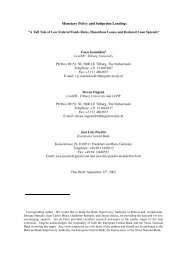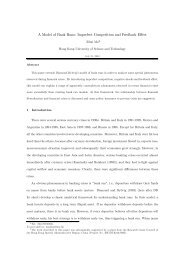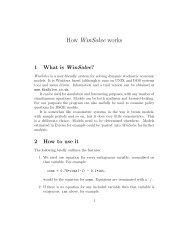Macroeconomics of the Franco-Prussian War Indemnity
Macroeconomics of the Franco-Prussian War Indemnity
Macroeconomics of the Franco-Prussian War Indemnity
Create successful ePaper yourself
Turn your PDF publications into a flip-book with our unique Google optimized e-Paper software.
Hong Kong Institute for Monetary Research<br />
The historical record for France can best be seen through some time series graphs. The dark line in<br />
Figure 1 shows France’s annual current account balance as a share <strong>of</strong> GDP. Consistent data are available<br />
thanks to <strong>the</strong> achievement <strong>of</strong> Lévy-Leboyer and Bourguignon (1990); details are given in Appendix B. In<br />
<strong>the</strong> years before <strong>the</strong> transfer, France ran a current account surplus, averaging roughly 5 percent <strong>of</strong> GDP.<br />
Next, we use <strong>the</strong> indemnity payments estimated by Lévy-Leboyer (1977): 1.435 billion F in 1871, 1.801<br />
billion F in 1872 and 2.295 billion F in 1873, or 7.24%, 8.68%, and 11.1% <strong>of</strong> GDP. Adding <strong>the</strong>se to <strong>the</strong><br />
<strong>the</strong> current account balance shows <strong>the</strong> balance net <strong>of</strong> <strong>the</strong> indemnity. As a share <strong>of</strong> GDP, this net figure<br />
is shown in <strong>the</strong> dotted line in Figure 1. Clearly <strong>the</strong> indemnity was greater than <strong>the</strong> o<strong>the</strong>r components <strong>of</strong><br />
<strong>the</strong> current account during those years, so a significant part <strong>of</strong> it was financed by selling assets or by<br />
borrowing internationally. This borrowing to finance a lump-sum loss <strong>of</strong> national wealth and to smooth<br />
consumption seems consistent with <strong>the</strong> intertemporal approach to <strong>the</strong> current account. Of course, to<br />
formally test a model <strong>of</strong> <strong>the</strong> current account requires that we model o<strong>the</strong>r shocks as well. Both saving<br />
and investment, as shares <strong>of</strong> GDP, fell sharply from 1870 to 1871, but savings recovered more rapidly,<br />
as is also reflected in <strong>the</strong> current account series in Figure 1. Gavin (1992) drew attention to <strong>the</strong>se separate<br />
changes in saving and investment and <strong>the</strong>ir contributions to post-war current account surpluses.<br />
Much <strong>of</strong> <strong>the</strong> <strong>the</strong>oretical work on <strong>the</strong> transfer problem has focused on <strong>the</strong> effect <strong>of</strong> a transfer on <strong>the</strong> terms<br />
<strong>of</strong> trade <strong>of</strong> <strong>the</strong> donor and <strong>of</strong> <strong>the</strong> recipient. The terms <strong>of</strong> trade is defined as <strong>the</strong> ratio <strong>of</strong> import prices to<br />
export prices: s ≡ p m /p x . Figure 2 shows <strong>the</strong> French terms <strong>of</strong> trade (solid line) and <strong>the</strong> trade balance as<br />
a share <strong>of</strong> GDP (dashed line). The figure shows that <strong>the</strong> French terms <strong>of</strong> trade deteriorated during <strong>the</strong><br />
early 1870s, as predicted by standard models <strong>of</strong> international transfers (and, for <strong>the</strong> 1920s, by Keynes).<br />
Later sections <strong>of</strong> <strong>the</strong> paper examine whe<strong>the</strong>r <strong>the</strong>ory can explain <strong>the</strong> quantitative change in <strong>the</strong> terms <strong>of</strong><br />
trade.<br />
The <strong>the</strong>ory applies to per capita measures, and so we deflate quantities using Mitchell’s (1998) mid-year<br />
estimates. In many applications, this transformation would not matter, for French population stagnated<br />
during this period, growing by only 0.36% per year from 1861 to 1866 and by 0.54% per year from 1872<br />
to 1876. In this case, though, we need to adjust for <strong>the</strong> loss <strong>of</strong> Alsace and Lorraine in 1871, as <strong>the</strong><br />
Mitchell data do. Those regions comprised roughly 4% <strong>of</strong> <strong>the</strong> French population.<br />
Figure 3 shows estimates <strong>of</strong> <strong>the</strong> paths <strong>of</strong> real per capita output, consumption, and government spending.<br />
These series are measured by dividing <strong>the</strong> nominal series by <strong>the</strong> cost <strong>of</strong> living and <strong>the</strong> population series.<br />
The solid line is real output, while <strong>the</strong> dotted line gives a measure <strong>of</strong> aggregate consumption. Both<br />
series dropped sharply during <strong>the</strong> war, <strong>the</strong>n recovered. Output was disrupted by <strong>the</strong> occupation and<br />
loss <strong>of</strong> Alsace-Lorraine, by <strong>the</strong> siege <strong>of</strong> Paris, by <strong>the</strong> Paris Commune, and by <strong>the</strong> political uncertainty<br />
associated with <strong>the</strong> founding <strong>of</strong> <strong>the</strong> Third Republic. Figure 3 suggests that <strong>the</strong> degree <strong>of</strong> consumption<br />
smoothing in fact was very limited, as <strong>the</strong> path <strong>of</strong> real consumption parallels that <strong>of</strong> real output. This<br />
evidence seems inconsistent with <strong>the</strong> intertemporal approach to <strong>the</strong> current account. Again, however, a<br />
complete model is needed to assess whe<strong>the</strong>r this path for consumption is consistent with a standard<br />
model <strong>of</strong> budgeting. In assessing <strong>the</strong> effects <strong>of</strong> <strong>the</strong> transfer, we later control for o<strong>the</strong>r shocks, such as<br />
<strong>the</strong> wartime jump in government spending, which also is shown in Figure 3 (dashed line).<br />
5








